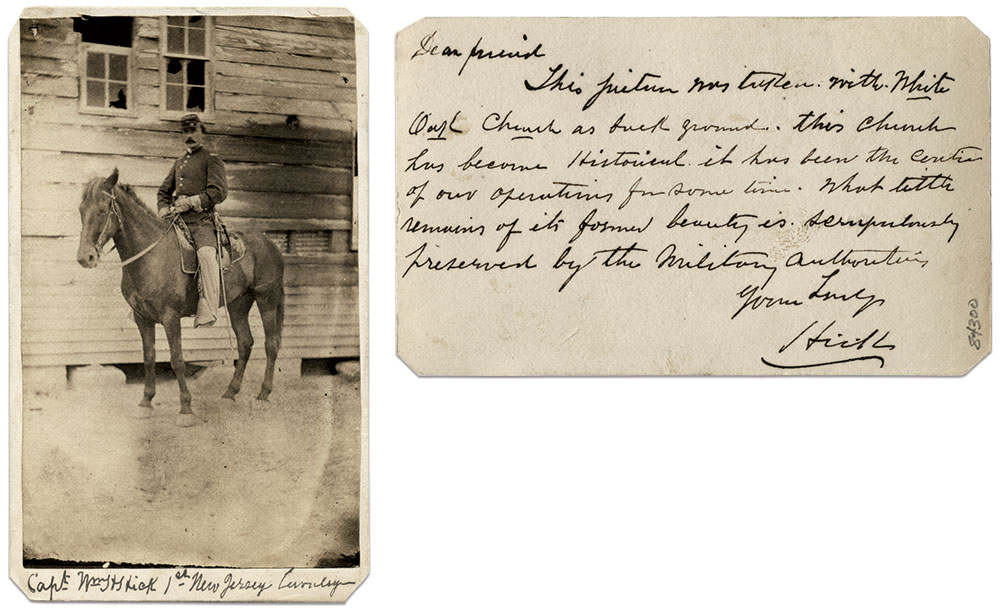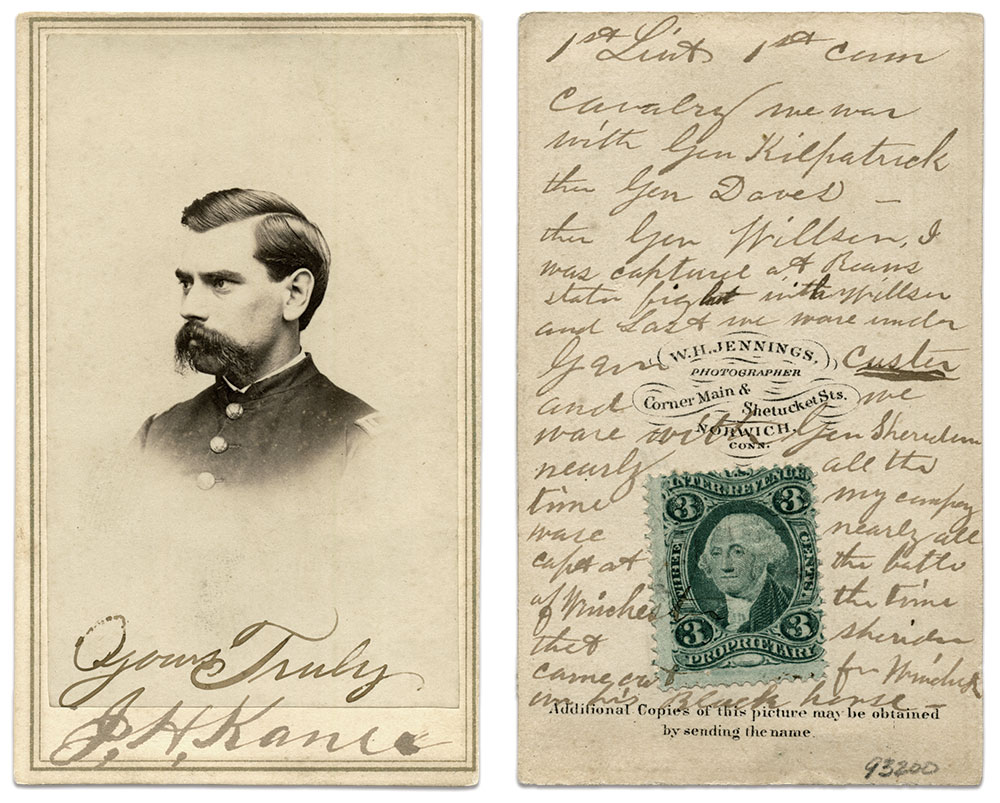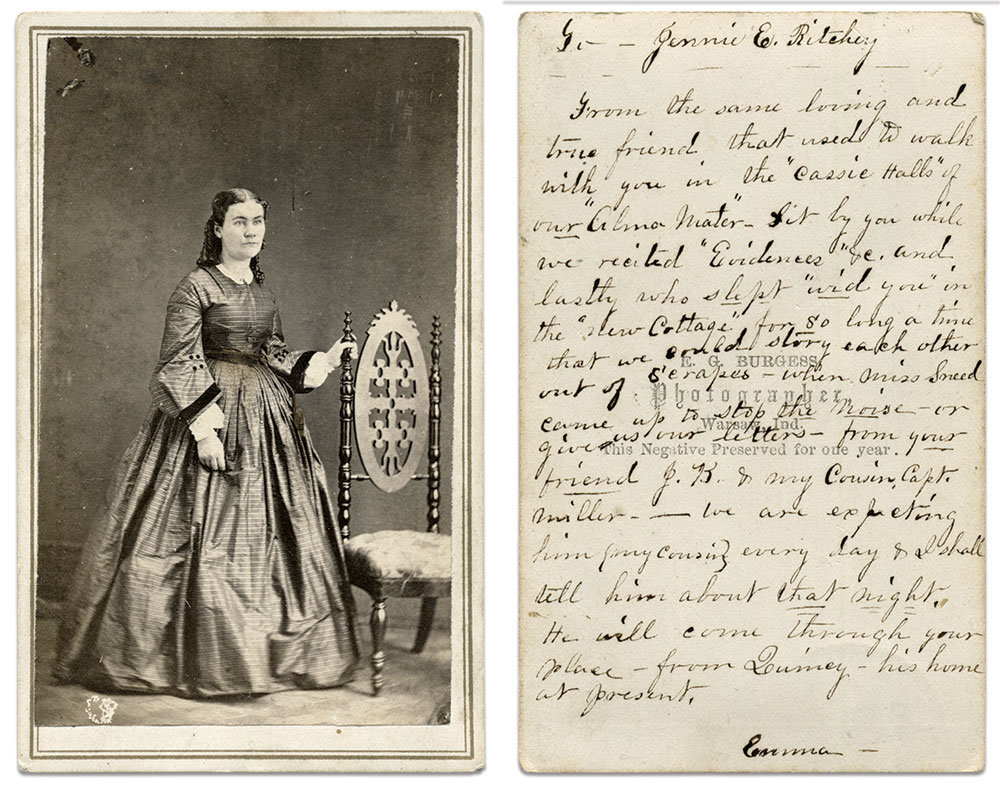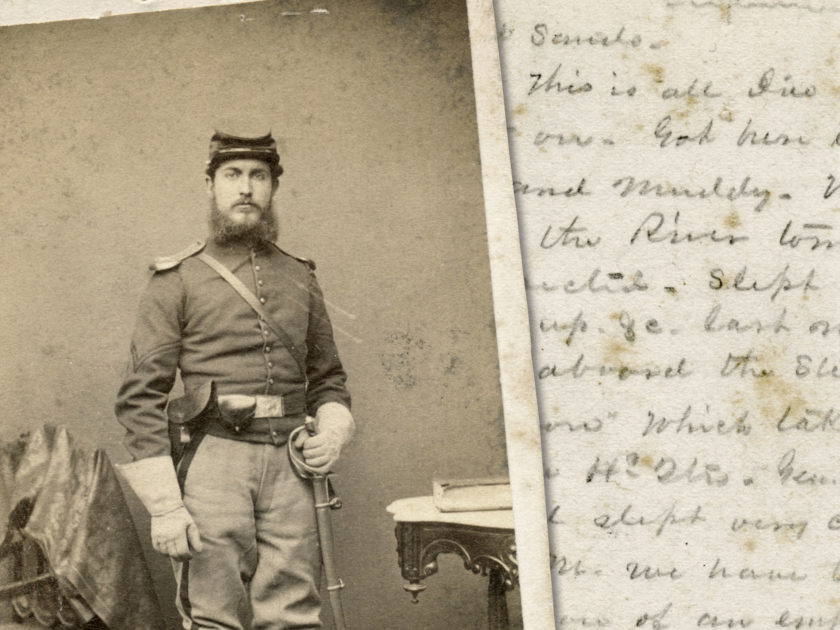Featuring images from the Rick Carlile Collection
Since the earliest days of photography when images on metal and glass plates dominated, portraits and notes were a natural pairing. Imagine a folded paper filled with romantic verse and tucked behind the ambrotype of a comely young woman. Or a soldier’s grim fate penned on crudely cut paper and pinned to the velvet lining of a case that contains his tintype. The introduction of the carte de visite to America on the eve of the Civil War made the pairing even more integrated. The backs of these paper prints created a perfect space for all sorts of information. Soldiers could record their names, companies and regiments, and have enough room left for a dedication. Some took it to the extreme and used the space for fuller communications as evidenced by these examples.
A half-century later, long after the carte de visite had faded from the American scene, picture postcards were all the rage. Though there were substantial differences in the two forms, the basic idea was the same.
Historic backdrop
Capt. William H. Hick of the 1st New Jersey Cavalry wrote this during the winter of 1862-1863, at which time the church and its environs were home to 20,000 Union soldiers of the VI Corps. The church was used as a hospital, a U.S. Christian Commission post and a photographer’s studio. Hick survived the war and served for several years in the regular army. He died in 1894.

Dear friend
This picture was taken with White Oak Church as back ground. This church has become Historical it has been the center of our operations for some time. What little remains of its former beauty is serreptitiously preserved by the Military Authorities
Yours Truly
Hick
“This is all I’ve got to write on”
Cpl. Alonzo Randall sent this letter card during the initial phase of the Peninsula Campaign, a massive operation to transport men and materials by water to southeast Virginia. His observation about the comfort of Army of the Potomac commander Maj. Gen. George B. McClellan was likely gleaned firsthand—Randall belonged to the Oneida Independent Cavalry of New York, which served as McClellan’s headquarters guard. The recipient of the penciled note, “Friend Sands,” is possibly Sands H. Goodin. Randall boarded with Sands and the rest of the Goodin family prior to his enlistment in the army in the fall of 1861. Though the campaign ended in failure for the Union, Randall came out of it with his sergeant’s stripes. He mustered out of the army in 1864 and lived until 1899.

Alexandria, Virginia
Sunday, Mch 30, 1862
Friend Sands,
This is all I’ve got to write on. Got here last Eve wet and muddy. Will go down the River tomorrow as expected. Slept in barn sitting up, & c. last night, but I got aboard the Steamer “Commodore” which takes down all the HdQtrs. Gen. McClellan &c, and slept very comfortable. This P.M. we have taken possession of an empty house and are very comfortable until we move. Boys all in good spirits. Write to Washington as usual. We are off for the wars. I’ll get my Boots sometime. I [unreadable] to all
Rmn Yours
A. Randall
Service with the great Union cavalry commanders
First Lt. James Hammond Kane of the 1st Connecticut Cavalry relates his war service by listing the generals with whom he and his Company I served: Hugh Judson Kilpatrick, Henry E. Davies, James H. Wilson, George Armstrong Custer and Philip H. Sheridan. Kane highlighted his capture during the First Battle of Ream’s Station, fought on June 29, 1864, on the raid led by Wilson and Brig. Gen. August V. Kautz. Kane also references Sheridan’s famous ride from Winchester, Va., to the battlefield of Cedar Creek on Oct. 19, 1864. Kane was still in rebel hands and did not gain his parole until the following month. He survived the war and lived until 1889. The style and substance of the writing suggests Kane intended this to be included with a letter or perhaps with other mementoes of his military experience.

1st Lieut 1st Conn Cavalry we was with Gen. Kilpatrick then Gen Davis—then Gen Willson, I was captured at Ream’s Station fight with Willson and Last we wore under Gen Custer and we wore with Gen Sheridan nearly all the time my company wore nearly all capt at the battle of Winchester the time that Sheridan came out for Winchester on his Black horse—
Awaiting Capt. Miller
The note on the back of this image begins as an inscription. Towards the end however, the timely reference to Capt. Miller and his travels is the type of content one might find in a letter.

To Jennie E. Ritchey
From the same loving and true friend that I used to walk with you in the “Cassie Halls” of our “Alma Mater,” Sit by you while we recited “Evidences” &c, and lastly who slept “aid you” in the “new Cottage” for so long a time that we could story each other out of Serapes—when Miss Sneed came up to stop the noise—or give us our letters—from your friend J.B. & my Cousin, Capt. Miller.—We are expecting him (my cousin) every day & I shall tell him about that night. He will come through your place—from Quincey—his home at present.
Emma—
Flirtatious “Battery Boy”
In his 43-word request, a smitten Union artilleryman makes a play for a portrait of a young lady. One wonders if a romance ensued, or if the relationship was purely platonic.

Miss Z.B.
If you can’t help it, you may laugh at the “Battery Boy,” conditionally & condition, that you send him such a photo of thyself, as hath Hattie Marsh in such close keeping, that he cannot even retaliate with the smile that he would
Buffalo Dec. 29th 1862
X Battery Boy
SPREAD THE WORD: We encourage you to share this story on social media and elsewhere to educate and raise awareness. If you wish to use any image on this page for another purpose, please request permission.
LEARN MORE about Military Images, America’s only magazine dedicated to showcasing, interpreting and preserving Civil War portrait photography.
VISIT OUR STORE to subscribe, renew a subscription, and more.

